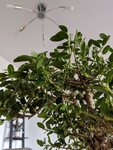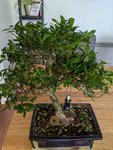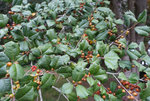@Ambobley - welcome to Bonsai Nut. This is a pretty good forum. Sometimes it takes a while to get someone who knows something about a given species to get around to giving a response.
@hinmo24t - this is NOT a yaupon holly. Yaupon Holly, Ilex vomitoria, is only native to USA. The OP clearly said Chinese or Japanese holly. Some holly are deciduous, some holly are evergreen. There are 480 species of holly distributed through Europe, Asia, North, Central and South America. There are more than 10 species native to North America, and there are over 20 species native to China. Asking which species of Ilex (holly) that the OP has is the most important key to deciding whether the leaves falling are a problem or not.
For a list of the more common holly species see Wikipedia

en.wikipedia.org
@Ambobley
Looking at the leaves of your tree, and knowing it comes from China, as you said you were originally told, chances are fair that it is Ilex crenata. There is an outside chance it is Ilex kaushue, or Ilex integra, called Mochi. These 3 species are the most common of the 20+ Chinese species of holly. All three are more or less evergreen. Leaves will live one to two years, and you will tend to get leaf drop, usually in late winter, or spring, with the oldest of the leaves falling. But older leaves can drop anytime.
If only a few of the oldest leaves are dropping, this is not a problem. Oldest leaves are the leaves furthest away from the tips of branches.
Question. Could you fill out your profile, to include roughly what city and what country you live in. This is an international forum, and you can get better advice, specific to your local climate if you include your location in your profile. You can edit your profile by clicking on the Icon in the upper right menu, next to the message icon.
All tree species used for bonsai are "outdoor trees", there are no "true" indoor trees. Most will grow better outdoors. But depending on your location, if it is autumn where you are at it may be too late in the season to put the tree outdoors. If you are in Australia or New Zealand, it is spring and time to put the tree outdoors. Most bonsai are grown outdoors, brought indoors to display briefly, then returned to the outdoors once "company leaves".
I'm going to assume you are in USA. Winter is coming. The 3 possible Chinese Holly species that this tree is, are all from sub-tropical to mild winter temperate climates. Ilex crenata is listed as evergreen, and winter hardy to -15 C, which is +5 F. This is roughly USDA zone 7. However not knowing where it was grown, I would assume it was greenhouse grown and has not been acclimated to falling autumn temperatures. I would keep it indoors for winter, protected from freezing, in the brightest window you have, or in an under lights set up. Besides, I would want to enjoy the ghoul on the swing, hangin in your tree. In winter, glass will be cooler than the air in the room, the cooler air falling down to the windowsill will give your holly its "winter rest" that it needs to set the buds for next year's growth.
So keep your tree bright, don't let the soil get too dry. I would not start pruning or wiring until spring, after the is a strong flush of new growth.
Styling. You have a nice dense amount of branching. This is good. It leaves you a lot of choices for styling. The down side is, this leaves you a lot of choices for styling. I hesitate to offer styling advice from the photos you supplied. In spring, when new growth as begun, take a better series of photos, from all 4 sides, taken with the camera lens on the same plane as the rim of the pot, pulled back far enough to get the whole tree. Then from these photos, you might be able to see the design. And it will be easier for others to offer their advice.
The current design is good. It is styled much as a tree that one would see in a park. It is an "informal upright", that is nice and dense. I would want to keep a fair amount of the density going forward. It is an asset of this tree. You also want to keep a branch to hang the swing from.
But there is no styling that needs to be done now. Focus on keeping it healthy through the winter. In spring you can repot if needed, and style the tree. Read up in the mean time. The most relevant information will be about Ilex crenata bonsai.










